A freak accident from his childhood in Iceland caused Gudmundur Olafsson’s right ankle to collapse. After 28 years of living in pain and more than 50 surgical operations he decided to amputate his lower leg entirely. For years, he wore the Proprio Foot – a prosthetic motorized ankle developed by an Icelandic company called Ossur which can automatically adjust the angle of the foot using its built-in sensors. Now, Olafsson prosthesis got a major upgrade: his new Proprio is controlled subconsciously by electrical signals sent from his brain to special sensors directly embedded in his muscles, all via the nerves in the muscle itself. Then a decoded signal is sent to a control unit which directs all the fine moving parts that make up his new, robotic leg. All his intentions are translated seamlessly by the sensors and Olafsson, now 48, can walk almost entirely like a normal person. “The first time, to be honest, I started to cry,” said Olafsson.

“Gummi” Olafsson is among two patients who received this experimental prosthesis. It’s been 14 months now since he’s wore it, and each day it’s getting better. What’s amazing is that there’s strain put on the muscles again, so they’ve started moving away from atrophy – always a big concern.

“You have to learn how to use those muscles again,” says Olafsson. “How to tighten them up, in front and back. And that’s the main thing. Those muscles start getting bigger, so you get better at walking. I have more stamina. My gait is better. I don’t limp as much,” he said to PopSci.
At the very core of this technology are the myoelectric sensors (IMES). Ossur claims these are “lifetime sensors” since they don’t require any batteries. The tiny sensors (3 millimeters-by-80 millimeters) are instead powered by magnetic coils embedded in the socket – a hollow component that fits over the residual limb and connects to the prosthesis. Compared to what Olafsson had to deal with in his youth, the implant surgery was a piece of cake. It only took 15 minutes and the sensors fit in a single-centimeter-long incision.

I couldn’t find anything about cost, though. These sort of details will likely surface once the prosthesis is out of clinical trial. Right now, Ossur is still busy collecting data and improving their prosthesis. For what it’s worth, it all looks very promising already!
Was this helpful?



